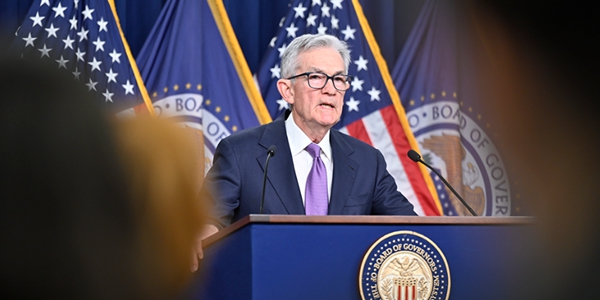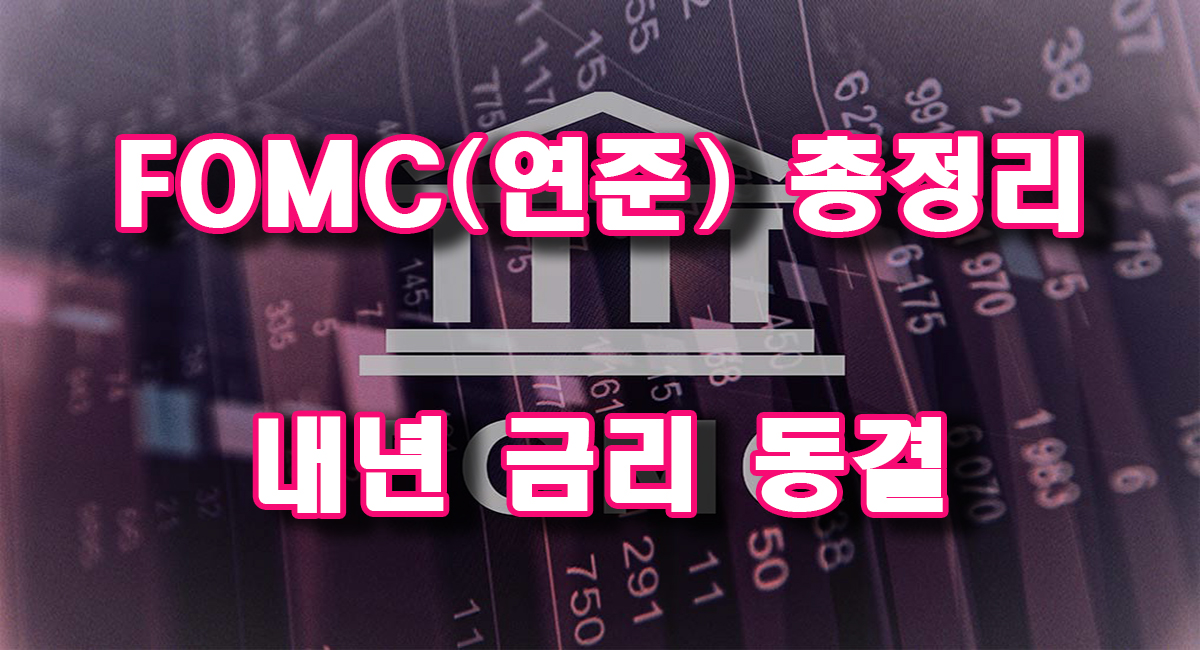목차
- 연준의 의미와 역할
- 연준의 구성인원과 일정
- 2024년 FOMC 기준금리 동결
- 인플레이션과 경기 전망
- 국채수익률의 변화와 시장 반응
- 미국 금리와 한국의 영향
- 결론
연준(FOMC)의 의미와 역할
FOMC는 Federal Open Market Committee의 약자로 우리말로 연방공개시장위원회 라고 불립니다.
연준은 미국의 중앙은행 역할을 하는 연방준비제도(Fed or FRB)의 산하 기관으로써 미국의 통화정책을 결정하고 시중 금리를 조절하는 중요한 기관 중 하나로, FOMC는 경제 상황을 고려하여 기준금리를 결정합니다. 쉽게 얘기해서 미국의 경제를 안정화하고 금융 시장을 지원하는 미국 경제의 가장 핵심적인 기관입니다.
연준의 구성인원과 일정
연준은 12명의 구성원으로 이루어진 위원회로, 1년에 8번 6주간격으로 2일간 회의를 개최하며 통화정책 방향과 기준금리 결정에 참여합니다. 회의 일정은 주요 경제 지표 발표 전후로 정해지며, 이를 통해 미국의 통화정책 방향을 결정합니다.
FOMC 회의 일정 : The Fed – Meeting calendars and information (federalreserve.gov)

2024년 FOMC 기준금리 동결
최근 FOMC 정례회의에서 미국 연방준비제도(Fed)는 기준금리를 5.25∼5.50%로 동결하며 내년에 0.25%씩 세차례 인하할 계획을 발표했습니다. 이는 연속 3회째의 동결으로, 통화정책의 진전과 함께 여전히 높은 수준의 인플레이션을 고려한 결과로 풀이됩니다. 연준은 이날 성명에서 미국 경기가 둔화하고 있어 기준금리를 동결하기로 결정했다고 설명했습니다.

인플레이션과 경기 전망
연준은 내년 말 기준금리를 4.6%로 하향 조정하며 인플레이션 둔화를 예상합니다. 이는 미국의 소비지출과 경제성장률에 대한 낙관적인 전망을 반영한 것으로, 예상치를 밑도는 인플레이션과 미약한 성장률을 고려한 것으로 보입니다.
19명의 연준 위원 중 11명은 최소 3회, 8명은 2회 이하의 금리 인하가 있을 것으로 전망했습니다. 연준의 이같은 결정에는 물가상승률 둔화를 전망했습니다. 연준은 내년 개인소비지출(PCE) 상승률을 전년대비 2.4%로 내다봤고 이는 지난 9월 대비 0.1%포인트 하향 조정한 것입니다. 이와 함께 내년 경제성장률을 1.4%로, 실업률은 현재 3.7%에서 내년 4.1%로 높아질 것으로 내다봤습니다. 노동시장에 대한 부정적 전망은 여전하지만 인플레이션 둔화를 예상한 것입니다.

국채수익률의 변화와 시장 반응
연준의 기준금리 인하 전망에 따라 미국 국채수익률은 하락하고 있습니다. 2년, 10년 만기 국채수익률은 각각 10bp 이상 하락하여 시장의 정책에 대한 민감한 반응을 보이고 있습니다.
미국 금리와 한국의 영향
미국의 기준금리는 한국의 금융시장 뿐만 아니라 전세계적으로 영향을 미칠 수 있습니다.
예를 들어, 원/달러 환율은 미국의 기준금리 변화에 민감하게 반응합니다. 미국의 금리가 하락하면 국제 투자자들은 미국 자산을 팔고 다른 국가 자산으로 자금을 이동시키는 경향이 있습니다. 이는 한국의 원/달러 환율이 상승하여 수출 기업에는 긍정적인 영향을 미칠 수 있습니다.
또한, 한국의 경제주체들은 미국 금리 변화에 따라 금리 수준에 영향을 받게 됩니다. 예를 들어, 한국의 기업들이 국제 자금 시장에서 자금을 조달하는 경우 미국 금리 하락으로 인해 금융비용이 감소할 수 있습니다. 이는 기업들이 투자를 늘리거나 자본 확충을 할 수 있는 여지를 제공할 것입니다.
또한, 미국의 경기 부양으로 수출이 증가할 경우 한국의 주요 수출 품목에 대한 수요가 증가할 것으로 예상됩니다. 특히 전자제품, 자동차 등의 산업은 미국과의 무역이 활발하게 이루어지고 있어 미국의 소비 증가는 한국의 수출에 긍정적인 영향을 미칠 것으로 생각됩니다.
하지만, 미국 금리 변화는 국제 금융시장에서의 불안 요소로 작용할 수도 있습니다. 글로벌 자금이 미국에서 다시 빠져나가면서 이에 따른 금융시장의 불안이나 환율 변동성이 증가할 가능성도 있습니다.
종합적으로, 미국의 기준금리 변화는 한국의 금융시장과 경제에 다양한 영향을 미칠 수 있으며, 이는 정책 결정과 기업 전략 수립에 있어 신중한 고려가 필요한 시점입니다.
결론
미국 연준은 경기 부양을 위해 기준금리를 인하하는 전망을 제시하면서도 여전히 높은 인플레이션을 고려하고 있습니다. 이는 미국 경제가 안정화되고 소비 지출이 증가할 것으로 예상되지만, 글로벌 시장에서의 불확실성은 여전히 존재합니다. 한편으로는 미국의 금리 정책이 국제 금융시장과 한국 주식시장에 미치는 영향을 고려한다면 투자에 있어서 큰 도움이 될 것입니다.

FOMC Interest Rate Decision and U.S. Economic Outlook
Table of Contents
- The Role and Significance of the Federal Reserve (FOMC)
- Composition and Schedule of the Federal Reserve
- FOMC Decision: Freeze on 2024 Interest Rates
- Inflation and Economic Outlook
- Changes in Treasury Yields and Market Response
- Impact of U.S. Rates on South Korea
- Conclusion
The Role and Significance of the Federal Reserve (FOMC)
The Federal Open Market Committee (FOMC), commonly known as the Federal Reserve, plays a pivotal role as the central banking authority in the United States. Under the Federal Reserve System (Fed or FRB), the FOMC determines U.S. monetary policy and regulates short-term interest rates. In simpler terms, it is a key institution for stabilizing the U.S. economy and supporting the financial market.
Composition and Schedule of the Federal Reserve
The Federal Reserve consists of 12 members who form a committee. They convene meetings eight times a year, approximately every six weeks, spanning two days each. The meeting schedule aligns with significant economic indicator releases, guiding decisions on U.S. monetary policy.
Check the FOMC Meeting Schedule
FOMC Decision: Freeze on 2024 Interest Rates
In the recent FOMC regular meeting, the Federal Reserve announced a decision to maintain the benchmark interest rates at a range of 5.25% to 5.50% and disclosed plans for three incremental decreases of 0.25% each in the coming year. This marks the third consecutive freeze in interest rates, considering advancements in monetary policy and the persistent high level of inflation.
Inflation and Economic Outlook
The Federal Reserve revised its forecast, lowering the year-end 2024 benchmark interest rate to 4.6%, anticipating a slowdown in inflation. This adjustment reflects an optimistic outlook for U.S. consumer spending and economic growth, taking into account lower-than-expected inflation and modest growth rates.
Out of the 19 Federal Reserve members, 11 foresee a minimum of three rate cuts, while 8 anticipate two or fewer. The decision aligns with a projection of subdued inflation. The Federal Reserve lowered its forecast for the Personal Consumption Expenditures (PCE) inflation rate to 2.4% compared to the previous year, a 0.1% reduction from September. Additionally, the forecast for the economic growth rate in the coming year stands at 1.4%, with an expected unemployment rate increase from the current 3.7% to 4.1%.
Changes in Treasury Yields and Market Response
Following the Federal Reserve’s anticipation of future interest rate cuts, U.S. Treasury yields are experiencing a decline. Both the 2-year and 10-year Treasury yields dropped by more than 10 basis points, indicating a sensitive market response to the policy decisions.
Impact of U.S. Rates on South Korea
U.S. interest rates can influence not only South Korea’s financial markets but also global markets. For instance, the USD/KRW exchange rate is highly responsive to changes in U.S. interest rates. A decrease in U.S. rates tends to encourage international investors to shift funds away from U.S. assets, potentially leading to an increase in the USD/KRW exchange rate, positively affecting South Korean export-oriented companies.
Furthermore, economic entities in South Korea may feel the impact of U.S. rate changes, especially if they rely on international funding. A reduction in U.S. rates could lower financial costs for Korean companies accessing funds in the global market, offering opportunities for increased investments or capital expansion.
Additionally, if U.S. economic stimulus results in increased U.S. consumer spending, South Korean industries, particularly electronics and automotive sectors engaged in active trade with the U.S., may experience heightened demand for their exports.
However, it’s crucial to note that changes in U.S. rates can also act as a source of uncertainty in global financial markets. An outflow of global funds from the U.S. could lead to increased financial market instability or exchange rate volatility.
Conclusion
In conclusion, the Federal Reserve’s inclination toward interest rate cuts reflects its commitment to economic stimulus, while still considering the challenges posed by lingering inflation. The stability of the U.S. economy and an anticipated increase in consumer spending are expected outcomes. However, the prevailing uncertainties in global markets warrant careful consideration in policy decisions and corporate strategic planning.



